One of my favorite sites for armchair botanizing is CalPhotos:
http://calphotos.berkeley.edu/
Type in a genus name and go exploring. So I did this with Silene, and there are some amazing species out there, why aren't these being grown?!? Here are some of my favorite EXTREME Silene species.
Silene serpentinicola (Serpentine Catchfly)
This is a California endemic, found in Del Norte Co. Amazing dwarf red-flowered species.
http://www.fs.fed.us/wildflowers/communities/serpentines/center/images/s...
http://calphotos.berkeley.edu/cgi-bin/img_query?rel-taxon=contains&where...
Silene salmonacea (Klamath Mountain catchfly)
This is a California endemic, found in Trinity Co, looks akin to S. hookeri, but look at those luscious orange colors in the 2nd and 3rd link below.
http://www.fs.fed.us/wildflowers/communities/serpentines/center/images/r...
http://www.calflora.org/cgi-bin/species_query.cgi?where-calrecnum=9477
http://calphotos.berkeley.edu/cgi-bin/img_query?rel-taxon=contains&where...
And while you're along for the ride, take a drive down Silene hookeri street.
http://calphotos.berkeley.edu/cgi/img_query?where-genre=Plant&where-taxo...
Silene campanulata var. glandulosa, Calusa Co, California
http://calphotos.berkeley.edu/cgi/img_query?query_src=photos_index&enlar...
Silene parishii (Los Angeles Co, California)
http://calphotos.berkeley.edu/cgi/img_query?query_src=photos_index&enlar...
http://calphotos.berkeley.edu/cgi/img_query?query_src=photos_index&enlar...
Silene suksdorfii (Pierce Co, Washington)
This one I fell in love with when seeing it on Burroughs Mountain, a spur off Mr. Rainier in Washington, with brightly veined pouchy flowers. Tried growing it from the NARGS seed exchange a couple times, grew tiny plants for a few years each time but eventutally lost them. Worth trying again.
http://calphotos.berkeley.edu/cgi/img_query?query_src=photos_index&enlar...
And lastly, I didn't include the photo links to S. californica, but judging from the CalPhotos images, there are some good dwarf forms of this otherwise tallish flame red species. You can go look.

Comments
Lori S. (not verified)
Re: Armchair botanizing for Extreme Silene
Fri, 02/26/2010 - 8:17pmWell, if anyone is looking for volunteers, they can just send me the plants! ;) I'd love to give them a try!
I'm especially taken by Silene suksdorfii - beautiful.
I did try some sort of a dwarf form of Silene californica... unfortunately at a time when I knew even less about growing alpines than I do now. (Poor thing - RIP.)
Mark McDonough
Re: Armchair botanizing for Extreme Silene
Tue, 04/06/2010 - 5:18amI was "googling" today and just happened to be referred to a page on the old SRGC Forum (Scottish Rock Garden Club) looking for plants other than Silene, but I came across the following photos of Silene hookeri and S. hookeri ssp. bolanderi cultivated expertly by SRGC member John Forrest... take a look at these beauties:
Silene hookeri ssp ingramii
http://www.srgc.org.uk/discus/messages/283/12091.jpg
Silene hookeri ssp ingramii - another form
http://www.srgc.org.uk/discus/messages/283/12092.jpg
Silene hookeri ssp hookeri - salmon form
http://www.srgc.org.uk/discus/messages/283/12093.jpg
Silene hookeri ssp bolanderi
http://www.srgc.org.uk/discus/messages/283/12094.jpg
http://www.srgc.org.uk/discus/messages/283/12095.jpg
Silene hookeri ssp bolanderi, seed grown with a buff colored flower
http://www.srgc.org.uk/discus/messages/283/12096.jpg
Trond Hoy
Re: Armchair botanizing for Extreme Silene
Tue, 04/06/2010 - 11:13amI prefere a sofa where I can relax my feet too!
I know I probably can't grow such plants outside but I would like to see them in situ!
Mark McDonough
Re: Armchair botanizing for Extreme Silene
Tue, 03/01/2011 - 11:13amClose-up of Silene variegata, a dwarf succulent-leaved species from Crete, from the Flickr photo galleries of Nick Turland.
http://www.flickr.com/photos/nturland/1363389276/
Updated: an even better set of photos from "Visit West Crete" site.
This species takes the prize for one of the most desirable small rock garden Silene ever!
http://www.west-crete.com/flowers/silene_variegata.htm
cohan (not verified)
Re: Armchair botanizing for Extreme Silene
Tue, 03/01/2011 - 10:37pmLots of cool species! the Cretan species is pretty amazing :o but so is the serpenticola, with both a great red and somewhat inflated calyces --one of my favourite features in this genus-- (I actually really like the flowers of our local weed sp, its just a bit too successful as a weed!)..
salmonacea has a great colour range too, can't see if it has inflated calyces or not..
Lori S. (not verified)
Re: Armchair botanizing for Extreme Silene
Sat, 03/05/2011 - 9:42pmOn the subject of "extreme" silene, here are a couple others that I like:
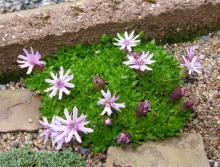
1) Silene davidii (the former or syn. S. kantzeensis, and still sold under that name)
http://www.efloras.org/florataxon.aspx?flora_id=3&taxon_id=242000737
2) Silene falcata - this one is native to Turkey. I like the red buds, particularly.
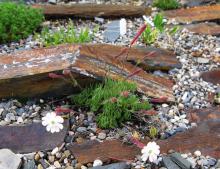
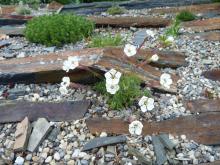
cohan (not verified)
Re: Armchair botanizing for Extreme Silene
Sat, 03/05/2011 - 10:10pmThese are both excellent! The first is just really cute, the second I like since I perversely like those species which remind me of our weeds, but which are small! I like the foliage on both too, but esp those little wispy tufts
Mark McDonough
Re: Armchair botanizing for Extreme Silene
Sun, 03/06/2011 - 7:07amLori, I second Cohan's message, both Silene species are AWESOME! I just spent about an hour looking through the Flora of China link on S. davidii, what an excellent species... did you see the really dark pink one? Such a neat growing species, and from the super long list of species in China, I suspect there are many other worthwhile species, some will hopefully make their way into cultivation.
Love everything I see with S. falcata, from the neat "wispy" asperula-like foliage, to the elongated red buds and the pristine white blooms.
Lori S. (not verified)
Re: Armchair botanizing for Extreme Silene
Sun, 03/06/2011 - 9:12amYes, the dark pink one (the 6th S. davidii photo at the Flora of China site; photo by R. Lee) is stunning!
The foliage on the plant in the first photo is significantly different from the rest of the photos; different subspecies or...?
Yeah, the foliage on Silene falcata is great too! It does seem to represent the extreme, as compared to the fairly broad-leaved North American species.
Mark McDonough
Re: Armchair botanizing for Extreme Silene
Sun, 03/06/2011 - 10:16amThe Flora of China folks have been adding photos to the flora, often taken by different people. I have noticed a number of mistaken IDs in those photos, particularly in genera I have a better understanding of (Allium for example). I see what you're saying, the foliage in the first photo link looks much more linear... probably a subspecies or a different species altogether.
Mark McDonough
Re: Armchair botanizing for Extreme Silene
Mon, 03/07/2011 - 12:25pmToday my armchair travels too me to the vast expanses of Plantarium Russia (a site for the vascular plants of Russia and neighboring countries). Nearly 400 Silene species are listed with maybe half of them being synonyms, that's still a lot of Silene. There are photos for only some species listed, so rather than wade through hundreds of photos, and finding lots of ugly weedy Silene species (many are of that persuasion), I list selected links to species that caught my attention and rock-gardening sensibilities.
The homepage for this site is: http://www.plantarium.ru/
Unless you speak or read Russian, it is imperative to have the Google Translate plugin installed into your internet browser, otherwise you won't know what buttons to click on. There are extensive collections of plant photos on this site, very worthwhile browsing through. In fair use, I include one screen shot of Silene lacera (Oberna lacera) from Dagestan, photo links below.
Oberna lacera, Dagestan (Syn. Silene lacera, Behenantha lacera)
Looks like a silene to me, but a special treasure, sparse crinkly basal leaves, prostrate red stems, plump chestnut red calyxes and ultra-fringy white flowers, stunning rock garden gem.
http://www.plantarium.ru/page/image/id/31379.html
http://www.plantarium.ru/page/image/id/5522.html
http://www.plantarium.ru/page/image/id/31378.html
Silene repens, Altai steppe, 1700m, (syn. S. amoena)
Photo of a plant past flowering, not stupendous but low growing.
http://www.plantarium.ru/page/image/id/76038.html
...a plant in fine flower:
http://www.plantarium.ru/page/image/id/48523.html
http://www.plantarium.ru/page/image/id/48042.html
Silene chlorantha, The Republic of Tatarstan
a tall, slender, elegant weed (call me crazy, but I like these types of weird plants)
http://www.plantarium.ru/page/image/id/61466.html
http://www.plantarium.ru/page/image/id/11013.html
Silene dubia, Carpathian Mountains (Syn. S. nutans ssp. dubia)
Distinctive, compact foliage, tallish slender stems and nodding slender cream flowers.
http://www.plantarium.ru/page/image/id/23895.html
Silene graminifolia, Tien Shan Mts
grassy basal foliage and refined light pink and white flowers
http://www.plantarium.ru/page/image/id/3376.html
Silene humilis, Dagestan
Distinctive! Prostrate, wooly gray leaves, narrow upright red flowers
http://www.plantarium.ru/page/image/id/31360.html
http://www.plantarium.ru/page/image/id/31362.html
Silene jailensis, Crimea
Rock garden gem, mats of thrifty foliage, nearly stemless round white flowers with red calyxes, photos show it is quite variable
http://www.plantarium.ru/page/image/id/78729.html
http://www.plantarium.ru/page/image/id/78728.html
http://www.plantarium.ru/page/image/id/25846.html
http://www.plantarium.ru/page/image/id/25843.html
Silene guntensis, Southern Kazakhstan, (Syn. S. apiculata, incanescens, kuhistanica)
low but loose tangle, narrow white flowers, just okay
http://www.plantarium.ru/page/image/id/72466.html
Silene kuschakewiczii, Southern Kazakhstan, 2800 m (Syn. S. apiculata, hispidula, kuhistanica)
low mats, pale pink, narrow dark calyx, another just okay species.
http://www.plantarium.ru/page/image/id/75681.html
Gastrolychnis tristis, Republic of Tuva, 1800 m (Syn: Silene bungei, Lychnis tristis, Melandrium triste)
Oh my, fantastic nodding inflated calyxes of white veined dark purple, red-violet petals, neat upright plant. Reminiscent of S. nigrescens.
http://www.plantarium.ru/page/image/id/16347.html
http://www.plantarium.ru/page/image/id/76370.html
Silene caucasica, Dagestan
nice low grower with trim white blooms and red calyxes
http://www.plantarium.ru/page/image/id/49760.html
http://www.plantarium.ru/page/image/id/49759.html
Silene chamarensis, Altai, 2900 m
another medium-low white-flowered one
http://www.plantarium.ru/page/image/id/75268.html
http://www.plantarium.ru/page/image/id/75269.html
Silene paucifolia, Urals, (Syn. S. chamarensis ssp. paucifolia, S. tenuis ssp. paucifolia)
choice dwarf plant, neat linear foliage, plump white calyxes and frilly white flowers.
http://www.plantarium.ru/page/image/id/73195.html
...in bud
http://www.plantarium.ru/page/image/id/72710.html
Another installment forthcoming...
Lori S. (not verified)
Re: Armchair botanizing for Extreme Silene
Mon, 03/07/2011 - 8:13pmSome incredible gems there! I'll be keeping a lookout for seeds!
As we eagerly await the next installment of extreme delights, here's another Silene, not so exotic-looking as many of those, but pretty - Silene saxifraga:
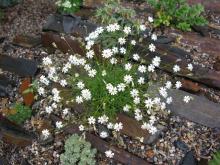
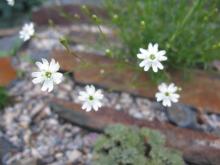
Some of our native ones can be pretty showy too, with attractive veining on the calyx, such as Silene parryi:
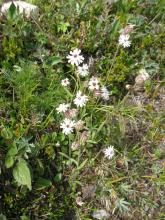
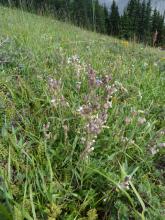
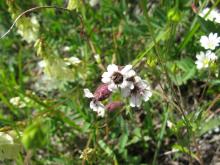
Hmmm, wait a minute... this next one seems to be something other than S. parryi... maybe S. furcata?
cohan (not verified)
Re: Armchair botanizing for Extreme Silene
Mon, 03/07/2011 - 9:48pmWow, Mark-- I like almost every one of those!
Lori, S parryi seems very nice and looks like it should be growable based on the habitat..
Mark McDonough
Re: Armchair botanizing for Extreme Silene
Tue, 03/08/2011 - 4:51amLori, two more worthy entries into the "Silene worth growing" class! :D
From your post on Prunus prostrata with a link on a Visit West Crete" tourist site, I checked out their plant photos, many of which are excellent. I found an even better photo of Silene variegata from Crete, so I updated the earlier post:
http://nargs.org/smf/index.php?topic=80.msg6769#msg6769
...or go to:
http://www.west-crete.com/flowers/silene_variegata.htm
cohan (not verified)
Re: Armchair botanizing for Extreme Silene
Tue, 03/08/2011 - 10:25amAmazing plant, for sure! I wonder just how hardy 1300 to 2400 m in Crete makes it?
Mark McDonough
Re: Armchair botanizing for Extreme Silene
Tue, 03/08/2011 - 10:32amOne never knows, but some mountain plants from the region, at even lower elevations, can be hardy. Take for example the marvelous late summer blooming (and night blooming) Cyprus endemic Saponaria cypria, found at 1350-1950 meters in the Troodos Mountains, it has been perfectly hardy outdoors for the past 10 years... see: http://nargs.org/smf/index.php?topic=325.msg3153#msg3153
Trond Hoy
Re: Armchair botanizing for Extreme Silene
Tue, 03/08/2011 - 12:51pmTroodos Mountains even have a ski resort!
Lori S. (not verified)
Re: Armchair botanizing for Extreme Silene
Tue, 03/08/2011 - 8:34pmWithin reason, of course (for example, this does not apply to tropicals ;D), I think one can only be sure by actually growing the plant! There seems to be so many exceptions to what one might expect in terms of hardiness, that only the results from trying it one's self are of much value. (And zone ratings are almost always absolute rubbish but don't get me started on that! ;D)
cohan (not verified)
Re: Armchair botanizing for Extreme Silene
Wed, 03/09/2011 - 12:06amQuite true, Lori-- I guess a lot of plants carry excess hardiness in their genes from past lives ;D We are currently z3 on the map :rolleyes: but I'm sure all the natives are good to z2 (which is more like our actual minimums, even if they are not common) , and probably colder..
I still don't mind seeing a zone rating if its based on temperature in habitat still not an absolute, and by no means the only factor, but its a starting point, especially for me now-- there are thousands of plants I'd love to try, so I figure I might as well start with those that at least come from someplace that gets moderately cold ;D eg, if I see several related species listed in Alplains catalogue, and one is zone 3 or 4, and others 6 or 7, I can start with the 3 or 4 and try others later (or wait and see how they did in your garden ;) ).. no guarantees ever of course...
Trond Hoy
Re: Armchair botanizing for Extreme Silene
Wed, 03/09/2011 - 12:52pmI can't trust your (I mean the USDA) hardiness ratings at all! The winters here are Z8 (not the last 2 years - they have been more like Z7!) but the summers are not!
cohan (not verified)
Re: Armchair botanizing for Extreme Silene
Wed, 03/09/2011 - 1:56pmYeah, an example of why Lori points out the limited value of those ratings--all they deal with is winter minimum, no consideration of moisture, when it comes, and summer temperatures... I believe someone somewhere (Alpine-L?) mentioned the origin of the system was for rating of tree hardiness in eastern North America..
I'd rather a plant description came with some details of the climatge in habitat (which are often hard to look up independently, especially for non-populated areas) but failing such a paragraph with every entry ;D I'll still take a mention of the temp minimum!
Trond Hoy
Re: Armchair botanizing for Extreme Silene
Thu, 03/10/2011 - 12:10amAgree! But you know, the winter hardiness depends on summer temperature(!) - at least the temperature in fall when the hardiness develops.
Lori S. (not verified)
Re: Armchair botanizing for Extreme Silene
Thu, 03/10/2011 - 5:30amErrr, well, those are undoubtedly factors, but my actual point is that the minimum temperature tolerance is poorly understood for so many perennial species, yet these flawed zone ratings are bandied about and copied from source to source as though they have been tested and found to be infallible, when the exact opposite is true. Zone ratings do much more "harm" than good in cold zones (don't you know that essentially all plants are "zone 6 to 9"? :P) and actually prevent people from trying plants that they could otherwise be growing successfully. (Ugghh, enough of beating that drum for the millionth time... I told you not to get me going on this! ;D)
cohan (not verified)
Re: Armchair botanizing for Extreme Silene
Thu, 03/10/2011 - 9:26amI plan on growing various 'hardy' cacti, and with some of these, my summers will definitely be more of a factor (or at least as much of one!) than the winters--in this case, presumably they need the high temperatures to make enough strong growth to survive winter; fall hardening is likely an issue as well.. I'll be aiming for a heat trapping planting for these, possibly with fall moisture covering...
Lori S. (not verified)
Re: Armchair botanizing for Extreme Silene
Thu, 03/10/2011 - 8:56pmNot such an "extreme" one, but nice enough to keep - Lychnis ajanensis:
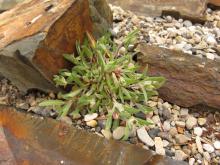
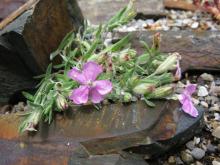
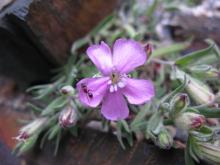
It was grown from seed in 2008. It is, apparently, endemic to Okhotsk-Kamchatkan Province of Russia (source: Wikipedia; http://en.wikipedia.org/wiki/Circumboreal_Region)
The plant pictured above seems to match other photos of L. ajanensis that I was able to find, but here's where it gets confusing...
I also have the following seed-grown plant labelled as L. ajacensis... though it has a rather different habit, and more nicely marked calyces:
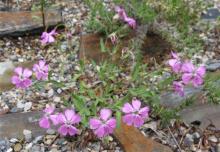
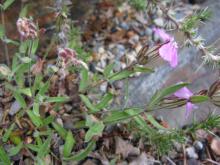
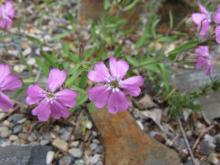
???
Trond Hoy
Re: Armchair botanizing for Extreme Silene
Fri, 03/11/2011 - 12:30amIt isn't easy to tell if they are the same, variable species or different species. But your plants certainly are different taxa! . . and both are handsome ;D
Mark McDonough
Re: Armchair botanizing for Extreme Silene
Fri, 03/11/2011 - 4:37pmLori, both are nice, but they do look like different plants. Here are some links from the same Plantarium Russia site, showing Lychnis ajanensis (syn: Silene ajanensis) from the Magadan Region (near the Sea of Okhotsk). Your second one almost looks like Silene caroliniana.
Lychnis ajanensis (syn: Silene ajanensis), Magadan Region, Russia
http://www.plantarium.ru/page/image/id/81507.html
http://www.plantarium.ru/page/image/id/81504.html
http://www.plantarium.ru/page/view/item/23409.html
Mark McDonough
Re: Armchair botanizing for Extreme Silene
Fri, 03/11/2011 - 9:39pmA few more from the Plantarium Russia site:
Silene pygmaea, Dagestan
loose and airy, ascending stems, nodding red flowers. I'd grow it if I had a chance ;-)
http://www.plantarium.ru/page/image/id/80166.html
Silene spergulifolia, Dagestan
charming species I'd grow in a heartbeat. Low bushy shrub-like growth, narrow thyme-like leaves, masses of white flowers and reddish calyxes.
http://www.plantarium.ru/page/image/id/76471.html
...masses of white flowers and red-veined calyxes:
http://www.plantarium.ru/page/image/id/77329.html
...this photo shows a prostrate form:
http://www.plantarium.ru/page/image/id/76449.html
Silene supina, Ukraine
interesting loose recumbent-stemmed plant, long conspicuous reddish calyxes, small cream flowers.
http://www.plantarium.ru/page/image/id/62110.html
http://www.plantarium.ru/page/image/id/62109.html
...some photos on this site show plants that look rather different:
http://www.plantarium.ru/page/image/id/22167.html
http://www.plantarium.ru/page/image/id/2940.html
Silene syreitschikowii, Crimea
similar to the preceding, low silver-leaf shrub like a lavender, racemes of creme olored blooms, usually with contrasting reddish calyxes. Charming in some of the more dwarf forms.
http://www.plantarium.ru/page/image/id/63878.html
http://www.plantarium.ru/page/image/id/63874.html
http://www.plantarium.ru/page/image/id/63876.html
...greener, and more dwarf, thyme-like form:
http://www.plantarium.ru/page/image/id/63872.html
Lori S. (not verified)
Re: Armchair botanizing for Extreme Silene
Fri, 03/11/2011 - 10:58pmIs it actually a shrub, Mark (or just "shrub-like" in habit)? Most unusual for a Silene, if so... but then who the heck knew there were so many fascinating ones in the world?!?
cohan (not verified)
Re: Armchair botanizing for Extreme Silene
Fri, 03/11/2011 - 11:58pmAll interesting, I think I like the last one most, esp if it is actually a shrub!
Lori S. (not verified)
Re: Armchair botanizing for Extreme Silene
Sat, 03/12/2011 - 9:02amMore on Silene syreitschikowii, and others:
http://translate.google.ca/translate?hl=en&sl=ru&u=http://www.flora.crimea.ua/smolevka/smolevka.html&ei=L6Z7Ta7zAcmCrQGl6rHvBQ&sa=X&oi=translate&ct=result&resnum=6&ved=0CEgQ7gEwBQ&prev=/search%3Fq%3DSilene%2Bsyreitschikowii%26hl%3Den%26client%3Dsafari%26rls%3Den%26prmd%3Divns]http://translate.google.ca/translate?hl=en&sl=ru&u=http://www.flora.crimea.ua/smolevka/smolevka.html&ei=L6Z7Ta7zAcmCrQGl6rHvBQ&sa=X&oi=translate&ct=result&resnum=6&ved=0CEgQ7gEwBQ&prev=/search%3Fq%3DSilene%2Bsyreitschikowii%26hl%3Den%26client%3Dsafari%26rls%3Den%26prmd%3Divns]http://translate.google.ca/translate?hl=en&sl=ru&u=http://www.flora.crimea.ua/smolevka/smolevka.html&ei=L6Z7Ta7zAcmCrQGl6rHvBQ&sa=X&oi=translate&ct=result&resnum=6&ved=0CEgQ7gEwBQ&prev=/search%3Fq%3DSilene%2Bsyreitschikowii%26hl%3Den%26client%3Dsafari%26rls%3Den%26prmd%3Divns
Mark McDonough
Re: Armchair botanizing for Extreme Silene
Sat, 03/12/2011 - 9:19amLori, did you notice from the photos of Silene syreitschikowii that it grows on beaches, apparently growing entirely in sea shells! I recognize some of those photos on the link you post, they're also found on the Plantarium Russia site. The two photos of Silene jailensis in the Flora of Crimea site add to the evidence that it is a good species, but apparently very rare.
Mark McDonough
Re: Armchair botanizing for Extreme Silene
Sat, 03/12/2011 - 2:35pmLooking through a flickr photo album of wild plants in Mexico, came across this photo showing a very attractive Silene laciniata.
http://www.flickr.com/photos/aztekium/241066260/in/photostream/
Mark McDonough
Re: Armchair botanizing for Extreme Silene
Sat, 03/12/2011 - 4:02pmOn the question of hardiness of plants from Crete, it always help to get a visual impression of the area, here's a good winter view:
http://www.west-crete.com/dailypics/photos1/2011large.jpg
cohan (not verified)
Re: Armchair botanizing for Extreme Silene
Sat, 03/12/2011 - 7:55pmGood visual for sure! And not the impression of the mediterranean I expect! Doesn't look very cold, though, ;) snow looks soft...lol
The Mexican album above is great too--- love to see some of the other Mexican flora, I usually see only cacti, succulents, bromeliads, maybe orchids and carnivores....
Mark McDonough
Re: Armchair botanizing for Extreme Silene
Sat, 03/12/2011 - 8:23pmCohan, I must have spent a full hour and a half getting sidetracked looking at that Mexican flickr photostream. I'm amazed at just how good these personal photo posting sites are, I find so much great stuff there, so it was indeed fun looking through the gallery for unusual rarely-pictured Mexican native plants; some great cacti and succulents too. I bookmark these for further armchair botanizing. ;)
Mark McDonough
Re: Armchair botanizing for Extreme Silene
Sat, 03/12/2011 - 9:07pmSilene elisabethae, Italy
A European Silene species that is universally misidentified in cultivation, almost everything under this name is completely wrong. Not sure why, it is a most distinctive and lovely Silene, with wide cartwheels of paddle shaped petals in deep purplish pink. Look at these photos, then judge your seedex-grown seed before donating them misidentified.
http://photos.v-d-brink.eu/Flora-and-Fauna/Europe/Alps-Giudicarian-Alps/...
http://photos.v-d-brink.eu/Flora-and-Fauna/Europe/Alps-Giudicarian-Alps/...
Silene acaulis, probably the most photographed alpine plant of all time. It is the species by which all other alpine Silene are measured, so it needs to be seen here as a "baseline". In Marijn van der Brink's photo galleries he has some that show variable forms and colors sitting side by side; thought you'd like to see them. Search Marijn's galleries for more incredible specimens of this classic alpine.
http://photos.v-d-brink.eu/Flora-and-Fauna/Europe/Alps-Dachstein/1057508...
http://photos.v-d-brink.eu/Flora-and-Fauna/Europe/2Alps-Ratikom/11094070...
Silene parryi, Northern Cascades, Washington, USA
A respectable short Western American Silene with full-petalled white flowers.
http://photos.v-d-brink.eu/Flora-and-Fauna/North-America/America-Washing...
http://photos.v-d-brink.eu/Flora-and-Fauna/North-America/Northwestern-Sa...
Silene campanulata ssp. glandulosa, Oregon, USA
nodding fat yellowish bells are tinged red, glandular, an intriguing character that I want to grow!
http://photos.v-d-brink.eu/Flora-and-Fauna/North-America/America-Oregon/...
http://photos.v-d-brink.eu/Flora-and-Fauna/North-America/America-Oregon/...
Silene californica
red red red, who doesn't love a low sprawling red Silene
http://photos.v-d-brink.eu/Flora-and-Fauna/North-America/America-Califor...
http://photos.v-d-brink.eu/Flora-and-Fauna/North-America/America-Califor...
...more dissected flower form:
http://photos.v-d-brink.eu/Flora-and-Fauna/North-America/America-Califor...
...more entire flower form:
http://photos.v-d-brink.eu/Flora-and-Fauna/North-America/America-Califor...
Silene bupleuroides, Iran, Zagros
full round white flower with red center, a beauty in this Iran form, apparently variable
http://photos.v-d-brink.eu/Flora-and-Fauna/Asia/nieuw-Iran-Central-Weste...
...another Iranian form, exceptionally long slender striped calyxes, pinwheel white flowers backed with pink
http://photos.v-d-brink.eu/Flora-and-Fauna/Asia/nieuw-Iran-Central-Weste...
http://photos.v-d-brink.eu/Flora-and-Fauna/Asia/nieuw-Iran-Central-Weste...
http://photos.v-d-brink.eu/Flora-and-Fauna/Asia/nieuw-Iran-Central-Weste...
Silene moorcroftiana, Pakistan
sugar pink wheels above mats of grassy dianthus-like foliage, charming
http://photos.v-d-brink.eu/Flora-and-Fauna/Asia/Pakistan-Karakorum/10569...
http://photos.v-d-brink.eu/Flora-and-Fauna/Asia/Pakistan-Karakorum/10569...
That's about it for a while. Feel free to add any other Silene that you think is a great rock garden plant. :D
cohan (not verified)
Re: Armchair botanizing for Extreme Silene
Sat, 03/12/2011 - 9:17pmAs I kept going, I realised I've looked at some of this guy's photos before, I just haven't made it all the way through!
Mark McDonough
Re: Armchair botanizing for Extreme Silene
Sat, 03/12/2011 - 9:21pmThis fellow has posted something like 1400 images, so it takes a while to get through them ;D
Mark McDonough
Now this is what I call an
Thu, 09/26/2013 - 7:07amNow this is what I call an extreme Silene (S. stenophylla):
http://news.nationalgeographic.com/news/2012/02/120221-oldest-seeds-regenerated-plants-science/
stuartmurray@xt... (not verified)
Not much wrong with the old
Mon, 09/30/2013 - 1:43amNot much wrong with the old standby S. acaulis. Hard to get the colour right with a blue cloth background, the second picture is the parent plant in a friends garden.